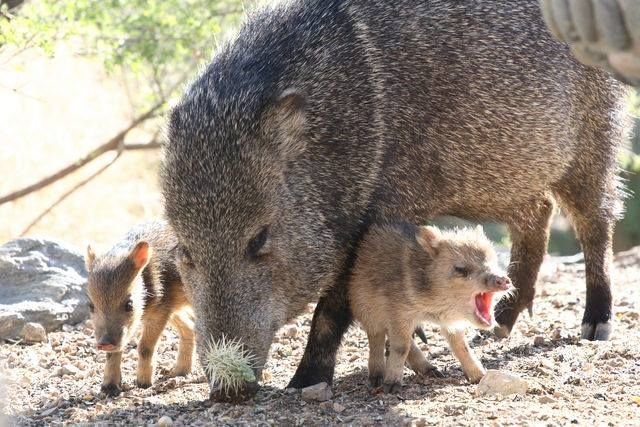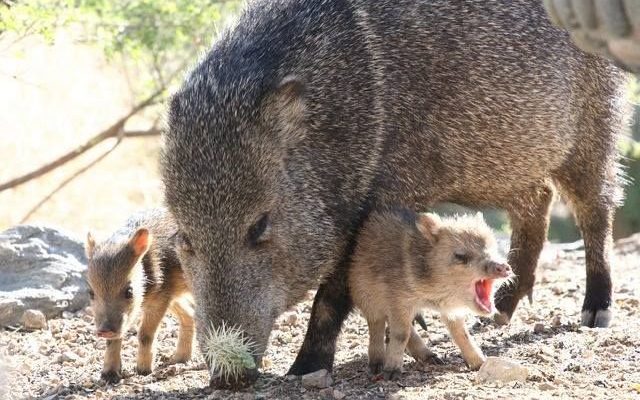
In the wild, survival is all about teamwork and instincts. Javelinas, also known as collared peccaries, have developed fascinating behaviors to ensure their young thrive. They are social animals, and their family groups, called sounders, are more than just a gathering of adults and piglets. Imagine a close-knit community where every member has a role to play. Let’s dive into the enchanting world of how javelinas raise their young in the wild.
Understanding Javelina Family Dynamics
Javelinas live in groups that typically consist of a few adult females, their young, and sometimes a few males. These units are often led by a dominant female. The bond among the javelinas is tight; they groom each other and communicate through a variety of sounds like grunts and squeals. This social structure is crucial for the upbringing of their young.
When a female javelina gives birth, she usually has a litter of about 2 to 4 piglets. The piglets are born with a nice coat of stripes, helping them blend into their surroundings—perfect for avoiding predators. The strong sense of community kicks in right away. Other females in the sounder help care for the young, allowing the mother a little break to regain energy. It’s like having a built-in babysitting service!
You might be wondering how long javelina piglets stay with their mothers. Well, they usually remain with their family until they’re around 6 months old. During this time, they learn vital survival skills from their parents and siblings, like foraging for food and spotting dangers in their environment.
The Role of Mothers in Raising Piglets
Mother javelinas are incredibly devoted to their young. After giving birth, they’re very protective, often staying close to their piglets and teaching them essential survival skills. Within a few hours of birth, piglets can start to walk and follow their mother. Isn’t that impressive?
One of the key responsibilities of a mother javelina is to teach her young how to find food. Javelinas are omnivores, munching on a mix of plants, fruits, and small animals. As the piglets grow, mama will lead them to different foraging spots. This not only feeds them but also helps them discover what to eat and what to avoid.
Here’s the thing: piglets are naturally curious. They’ll often explore their surroundings, but the mother keeps a watchful eye. If one gets too far away, she’ll call out to her little ones, reminding them of the importance of staying close to the group.
Protecting Young Javelinas From Predators
Life in the wild isn’t easy, and javelinas face their fair share of threats. Predators like coyotes, mountain lions, and even eagles can pose real dangers to their young. So, how do javelinas protect their piglets? Their strategy is pretty fascinating.
When danger is near, the entire sounder works as a unit. They become alert and often use a unique vocalization to signal the presence of a predator. The adults will form a protective barrier around the young, showcasing their fierce loyalty and protective instincts. It’s a teamwork approach, as they work together to fend off threats.
If you’ve ever seen a javelina come together like this, it’s a sight to behold. There’s movement, sounds, and a sense of urgency as they ensure the safety of their young. The unity of the group is a vital part of their survival strategy.
Teaching Life Skills to Piglets
As piglets grow, their mother and other adults in the sounder play a significant role in teaching them essential life skills. This education is a gradual process that combines play and exploration.
From a young age, piglets engage in playful activities like chasing each other. These games may seem like just fun, but they actually help develop their coordination and social skills. Plus, it’s a way for them to practice what they’d need in the wild, like running from danger or playing with their family.
Foraging is another critical area where adults step in. They’ll take the young ones to foraging sites, teaching them what to eat and how to dig or root around for food. Watching this process is like observing a teacher guiding a student through a lesson—a delightful glimpse into the bonding experience between adults and piglets.
Challenges Faced by Javelinas in Raising Young
Raising young is no walk in the park. Javelinas encounter a range of challenges that can complicate their parenting efforts. For instance, habitat loss due to urbanization and agriculture reduces their available space and food sources. This situation puts additional stress on the mothers and their piglets.
Moreover, climate changes can affect food availability and water sources. Javelinas, like many other wildlife species, need to adapt quickly to shifts in their environment. You might see them exploring further for food or changing their travel routes to avoid areas with high human activity.
Another challenge is the competition with other wildlife. Javelinas share their habitat with deer, rabbits, and other creatures that may also be searching for food. This competition can become fierce, forcing families to venture into less familiar areas in search of sustenance.
The Importance of Social Bonds in Javelina Communities
The social structure of javelina communities is vital not just for raising young, but also for overall survival. Bonds among members create a supportive environment that fosters safety and learning for the piglets.
Research shows that sounders can even recognize each other, which strengthens their family ties. The more cohesive the group is, the better they can guard against threats. Just like in human communities, strong relationships help everyone navigate the challenges of life.
You might also find it interesting that javelinas exhibit playful behavior with each other. These interactions are crucial for building trust and camaraderie among group members. When piglets see adults engaging in play, they learn the importance of social interaction, which is essential for their development.
In the wild, how javelinas raise their young is a captivating story of community, protection, and survival. Their social dynamics, nurturing instincts, and adaptability are impressive. Watching a javelina family in action is more than just a glimpse into their lives; it’s a reminder of how interconnected life in nature can be.
When you think about these unique creatures, remember that they thrive within their communities. The teamwork seen among javelinas highlights a powerful lesson: family and friends can make all the difference in overcoming life’s challenges. So next time you spot a javelina, take a moment to appreciate the intricate world hidden behind those adorable faces.

